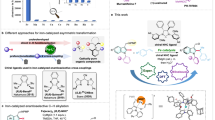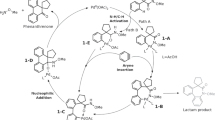Abstract
The development of novel synthons and efficient methods to synthesize chiral polycyclic indoles has been a hot topic in organic synthesis and medicinal chemistry owing to their broad applications in medicines, pesticides, and other functional molecules. Here, we disclosed novel indolyl substituted metal-allyl zwitterionic intermediates through the decarboxylation of conveniently available vinyl indoloxazolidones, which could be regarded as two types of dipolar species through the anionic delocalization. The palladium-π-allyl species tended to serve as an all-carbon 1,3-dipole in the asymmetric [3+2] cycloaddition with electron-deficient alkenes, which furnished polysubstituted cyclopenta[b]indoles with high regio- and stereoselectivities. Meanwhile, the iridium-π-allyl species was recognized as an aza-1,3-dipole in asymmetric [3+2] cycloaddition with in situ generated C1 ammonium enolates, affording pyrrolo[1,2-a]indoles with high diastereo- and enantioselectivities. In addition, the dipolar cycloadditions could be easily scaled-up and several synthetic transformations of the cycloadducts were demonstrated for the rapid synthesis of diverse chiral polycyclic indoles.

Similar content being viewed by others
References
Chen FE, Huang J. Chem Rev, 2005, 105: 4671–4706
Pritchett BP, Stoltz BM. Nat Prod Rep, 2018, 35: 559–574
Xu Z, Wang Q, Zhu J. Chem Soc Rev, 2018, 47: 7882–7898
Wang Y, Lan J. Sci China Chem, 2018, 61: 200–205
Richter JM, Ishihara Y, Masuda T, Whitefield BW, Llamas T, Pohjakallio A, Baran PS. J Am Chem Soc, 2008, 130: 17938–17954
Fernandez LS, Buchanan MS, Carroll AR, Feng YJ, Quinn RJ, Avery VM. Org Lett, 2009, 11: 329–332
Scarpi D, Faggi C, Occhiato EG. J Nat Prod, 2017, 80: 2384–2388
Raja S, Nakajima M, Rueping M. Angew Chem Int Ed, 2015, 54: 2762–2765
Cheng HG, Lu LQ, Wang T, Yang QQ, Liu XP, Li Y, Deng QH, Chen JR, Xiao WJ. Angew Chem Int Ed, 2013, 52: 3250–3254
Galván A, González-Pérez AB, Álvarez R, de Lera AR, Fañanás FJ, Rodríguez F. Angew Chem Int Ed, 2016, 55: 3428–3432
For selected reviews, see: (a) Trost BM, Crawley ML. Chem Rev, 2003, 103: 2921–2944
Qu J, Helmchen G. Acc Chem Res, 2017, 50: 2539–2555
Cheng Q, Tu HF, Zheng C, Qu JP, Helmchen G, You SL. Chem Rev, 2019, 119: 1855–1969
For selected reviews, see: (a) Weaver JD, Recio Iii A, Grenning AJ, Tunge JA. Chem Rev, 2011, 111: 1846–1913
Allen BDW, Lakeland CP, Harrity JPA. Chem Eur J, 2017, 23: 13830–13857
De N, Yoo EJ. ACS Catal, 2018, 8: 48–58
Shintani R, Murakami M, Hayashi T. J Am Chem Soc, 2007, 129: 12356–12357
For selected examples, see: (a) Shintani R, Park S, Shirozu F, Murakami M, Hayashi T. J Am Chem Soc, 2008, 130: 16174–16175
Shintani R, Tsuji T, Park S, Hayashi T. J Am Chem Soc, 2010, 132: 7508–7513
Mao B, Liu H, Yan Z, Xu Y, Xu J, Wang W, Wu Y, Guo H. Angew Chem Int Ed, 2020, 59: 11316–11320
Wang C, Tunge JA. J Am Chem Soc, 2008, 130: 8118–8119
For selected examples, see: (a) Li TR, Tan F, Lu LQ, Wei Y, Wang YN, Liu YY, Yang QQ, Chen JR, Shi DQ, Xiao WJ. Nat Commun, 2014, 5: 5500
Wei Y, Lu LQ, Li TR, Feng B, Wang Q, Xiao WJ, Alper H. Angew Chem Int Ed, 2016, 55: 2200–2204
Guo C, Fleige M, Janssen-Müller D, Daniliuc CG, Glorius F. J Am Chem Soc, 2016, 138: 7840–7843
Mei GJ, Bian CY, Li GH, Xu SL, Zheng WQ, Shi F. Org Lett, 2017, 19: 3219–3222
Wang Y, Xiong Q, Lu L, Zhang Q, Wang Y, Lan Y, Xiao W. Angew Chem Int Ed, 2019, 58: 11013–11017
Knight JG, Ainge SW, Harm AM, Harwood SJ, Maughan HI, Armour DR, Hollinshead DM, Jaxa-Chamiec AA. J Am Chem Soc, 2000, 122: 2944–2945
Khan A, Yang L, Xu J, Jin LY, Zhang YJ. Angew Chem Int Ed, 2014, 53: 11257–11260
Ohmatsu K, Imagawa N, Ooi T. Nat Chem, 2014, 6: 47–51
Ohmatsu K, Kawai S, Imagawa N, Ooi T. ACS Catal, 2014, 4: 4304–4306
For selected examples, see: (a) Rong ZQ, Yang LC, Liu S, Yu Z, Wang YN, Tan ZY, Huang RZ, Lan Y, Zhao Y. J Am Chem Soc, 2017, 139: 15304–15307
Yang LC, Rong ZQ, Wang YN, Tan ZY, Wang M, Zhao Y. Angew Chem Int Ed, 2017, 56: 2927–2931
Wei Y, Liu S, Li MM, Li Y, Lan Y, Lu LQ, Xiao WJ. J Am Chem Soc, 2019, 141: 133–137
Gao X, Xia M, Yuan C, Zhou L, Sun W, Li C, Wu B, Zhu D, Zhang C, Zheng B, Wang D, Guo H. ACS Catal, 2019, 9: 1645–1654
Zeng R, Li JL, Zhang X, Liu YQ, Jia ZQ, Leng HJ, Huang QW, Liu Y, Li QZ. ACS Catal, 2019, 9: 8256–8262
Zhang X, Li X, Li JL, Wang QW, Zou WL, Liu YQ, Jia ZQ, Peng F, Han B. Chem Sci, 2020, 11: 2888–2894
Singha S, Serrano E, Mondal S, Daniliuc CG, Glorius F. Nat Catal, 2020, 3: 48–54
Uno H, Punna N, Tokunaga E, Shiro M, Shibata N. Angew Chem Int Ed, 2020, 59: 8187–8194
Yang WL, Li CY, Qin WJ, Tang FF, Yu X, Deng WP. ACS Catal, 2016, 6: 5685–5690
Zhang J, Ni T, Yang WL, Deng WP. Org Lett, 2020, 22: 4547–4552
Zheng X, Sun H, Yang WL, Deng WP. Sci China Chem, 2020, 63: 911–916
During the preparation of our manuscript, Shi and co-workers reported Pd-catalyzed [3+2] cycloaddition and allylic amination of vinyl ox-azoloindol-3-ones in high efficiency. According to their report, π-allyl-Pd zwitterion intermediate exclusively served as a nitrogen-carbon-carbon building block in the [3+2] cycloaddition and only 63% yield and 20% ee for one single example was obtained in the asymmetric version, see: Hang QQ, Liu SJ, Yu L, Sun TT, Zhang YC, Mei GJ, Shi F. Chin J Chem, 2020, 38: 1612-1618. To be noticed, the indolyl metal-π-allyl zwitterion intermediate was designed as both all-carbon and aza-1,3-dipoles through anionic delocalization in our study and excellent enantioselectivities were obtained
Morrill LC, Smith AD. Chem Soc Rev, 2014, 43: 6214–6226
Jiang X, Beiger JJ, Hartwig JF. J Am Chem Soc, 2017, 139: 87–90
Acknowledgements
This work was supported by the National Natural Science Foundation of China (21901072), the China Postdoctoral Science Foundation (2019T120310) and Shanghai Sailing Program (18YF140560). Prof. Ying-Chun Chen of Sichuan University is acknowledged for helpful discussions. The authors thank the Research Center of Analysis and Test of East China University of Science and Technology for the assistance with the HRMS and NMR analyses.
Author information
Authors and Affiliations
Corresponding authors
Additional information
Conflict of interest
The authors declare no conflict of interest.
Electronic supplementary material
11426_2020_9854_MOESM1_ESM.pdf
Catalytic asymmetric dipolar cycloadditions of indolyl delocalized metal-allyl species for the enantioselective synthesis of cyclopenta [b]indoles and pyrrolo[1,2-a]indoles
Rights and permissions
About this article
Cite this article
Tian, F., Yang, WL., Ni, T. et al. Catalytic asymmetric dipolar cycloadditions of indolyl delocalized metal-allyl species for the enantioselective synthesis of cyclopenta [b]indoles and pyrrolo[1,2-a]indoles. Sci. China Chem. 64, 34–40 (2021). https://doi.org/10.1007/s11426-020-9854-3
Received:
Accepted:
Published:
Issue Date:
DOI: https://doi.org/10.1007/s11426-020-9854-3




